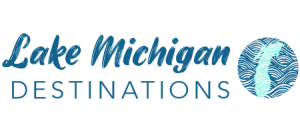Photos by Todd and Brad Reed Photography | Lake Michigan Destinations
Ludington’s North Breakwater Light
You’ve seen it in numerous photographs, and it is now ranked #1 lighthouse to visit in Michigan…plus The Weather Channel voted it one of the top 10 lighthouses to see in the U.S. The North Breakwater Light is Ludington’s focal point, and a great place to watch the sunset or wave at the S.S. Badger carferry as it cruises out onto Lake Michigan. The breakwall leading out to the light is a popular venue for fishermen and those who enjoy walking the mile-long round trip.
Lighthouse History & Facts
The white, pyramid shaped tower that is known as the Ludington North Breakwater Light (not an official lighthouse, since a house has never been attached to it) has a history that’s as fascinating as its structure. With $6,000 from Congress, the first Ludington light was constructed on the outer end of the south pier, and lit in 1871. Standing only 25 feet, the upper section housed a service room, which the light keeper could use during inclement weather. Money was no problem when it came to constructing Lake Michigan pierhead lighthouses, but Congress frequently dragged its feet in appropriating funds for the construction of keeper’s dwellings. Edwin Slyfield, light keeper in 1891, encountered dangerous conditions when he had to navigate the pier during November gales in order to service the light. It wasn’t until 1900 that a keeper’s quarters was finally constructed, and Mr. Slyfield and his family finally had a home.
The Army Corps of Engineers recommended in 1906 that a pair of timber breakwaters be constructed in an arrowhead formation to protect the entrance to the harbor. Work was completed on this project in 1914, and it became clear that the present light was not adequate for the number of carferries entering the harbor. Five years later, the timber breakwaters began to decay, and concrete structures were approved as a replacement. In 1923, it was decided that a new light should be built at the end of the North Breakwater, rather than the south side. So in 1924, the present tower began to take shape, fabricated of steel plates over a steel skeleton. This four-sided, white pyramidal tower was built with four porthole windows on each of the three decks. The unusual shape was designed to deflect the strong waves of Lake Michigan. A fourth-order Fresnel lens, manufactured in the United States rather than France, was installed in the new station’s lantern.
The North Breakwater Light was automated in 1972, and the Fresnel lens (now on display at Historic White Pine Village) was replaced in 1995 by a Tidelands Signal 300 mm acrylic optic. In 1994, the crib on which the light sits settled, and the tower tilted four degrees to the northeast. Cost to repair it was considered excessive, so the Army Corps of Engineers decided it was safe and to leave it as is. Looking at the North Breakwater Lighthouse today, the tilt can still be seen.
Northwest Michigan Lighthouses
From Ludington north to the tip of the Leelanau Peninsula, there are a dozen lighthouses to visit!

Manistee North Pierhead Lighthouse
photo by Todd and Brad Reed Photography
View Lighthouses in Northwest Michigan
- North Breakwater Light, Ludington
- Big Sable Point Lighthouse, Ludington State Park
- North Pierhead Lighthouse, Manistee
- Portage Lake North Pierhead, Onekama
- North Breakwater Light, Frankfort
- Point Betsie Lighthouse, Frankfort
- Robert H. Manning Memorial Light, Empire
- South Manitou Island Lighthouse, Glen Arbor Township
- North Manitou Shoal Light Station, Leland Township
- South Fox Island Lighthouse, Northport
- Grand Traverse Lighthouse, Northport
- Mission Point Lighthouse, Traverse City
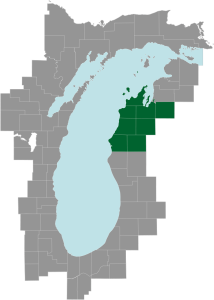
Travel Northwest Michigan
Featured Towns
Featured Counties
More Lighthouses Around Lake Michigan
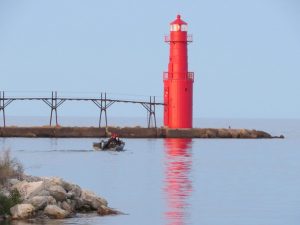
Algoma Pierhead Lighthouse
The Algoma Light, is a red, steel structure overlooking Lake Michigan. In 1932, the lighthouse that is in place today was relocated to Algoma.
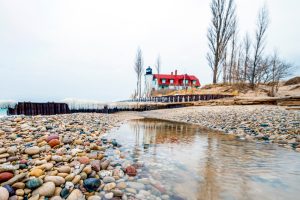
Point Betsie Lighthouse
Standing tall and proud along the shores of Lake Michigan, Point Betsie marks the southern entrance to the Manitou Passage.
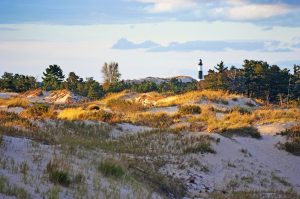
Lake Michigan Lighthouses
Lake Michigan has over 50 beautiful lights, with the majority in Michigan and Wisconsin, and more along the Illinois and Indiana lakeshore.
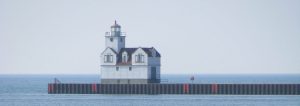
Kewaunee Pierhead Lighthouse
The Kewaunee Pierhead Lighthouse is one of only 6 in Wisconsin where a fifth-order Fresnel lens is still in use.
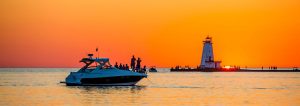
Ludington North Breakwater Light
Ludington’s North Breakwater Lighthouse is Ludington’s focal point and The Weather Channel ranks it in the top 10 lighthouses in the U.S.
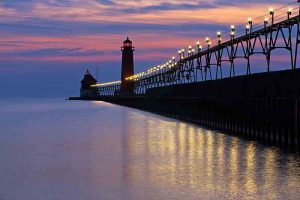
Grand Haven Lighthouse & Pier
The Grand Haven Lighthouse has two lights on the south pier, both painted red, that are connected by a lighted catwalk.
